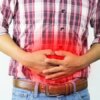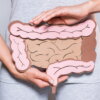
Ulcerative colitis is one of the main forms of inflammatory bowel disease. This leads to inflammation along the gut lining in a continuous fashion in the large intestine.
The degree of the inflammation and how much of the large intestine is affected varies between individuals.
This can also lead to one of the most common symptoms of ulcerative colitis, pain [Source: Pubmed].
What are the Causes of Ulcerative Colitis?
While the exact cause of the onset of the disease is unknown, several factors are understood to be involved.
These include:
- Imbalances in gut bacteria
- Alteration in the immune response
- Environmental factors
Additional factors that increase the risk of developing this condition include:
- Age – an increase in onset appears to be in the second and third decade of life and also between 50 and 80 years of age.
- Race and ethnicity – an increase in Ulcerative Colitis is noted in those of Jewish heritage
- Genetics – up to 14% of those with the condition have a family history of inflammatory bowel disease.
- Diet – the western diet (which involves high processes of carbohydrates and meats) is associated with an increased risk of the disease.
- Gut bacteria – imbalances in the gut microbiome may lead to changes in the immune response in the gut. [Source: Pubmed]
What are the symptoms of Ulcerative Colitis?
The most common presentation of this disease includes specific gut symptoms.
These are:
- Bloody diarrhoea (with or without mucus)
- Rectal urgency
- Tenesmus (the feeling that you need to pass stools, even though your bowels are already empty)
- Abdominal pain which is commonly relieved after passing a stool
A smaller proportion of those with Ulcerative Colitis may have constipation as opposed to diarrhoea. [Source: Pubmed]
While not classed as being diagnostic, a set of specific symptoms have been associated with an increased likelihood of having the disease.
These include:
- Anaemia
- Weight loss of more than 5kg in the last 12 months
- Having more than 4 bowel movements per day [Source: Pubmed]
It is also common for the symptoms to start slowly as intermittent attacks that gradually become more and more frequent. In some, these symptoms can become so severe that they may require hospitalisation. [Source: Pubmed]
Is Pain Normal in Ulcerative Colitis?
While less of a central feature than in Crohn’s disease, a common symptom of this condition is abdominal pain. While there may be specific triggers for the onset of this pain or stomachache, it is often resolved by a bowel movement.
It is more common for the abdominal pain in Ulcerative Colitis to be more extreme in those with a type of Colitis termed ‘pancolitis’. This is where the entire large intestine (colon) is inflamed. [Source: Pubmed]
If this pain becomes more acute in nature and the individual has a raised temperature (a fever) testing may be required. A CT scan of the stomach/ abdomen may be used to rule out any of the complications of this disease. [Source: Science Direct]
Ulcerative Colitis can be classified into 3 main groups. Mild, moderate and severe. This is based on the Truelove-Witts criteria.
| Mild | Moderate | Severe | |
| Bowel movements | Less than 4 per day | 4 or more | 6 or more |
| Blood | With or without | With blood | With blood |
| Pain | Mild cramping | Abdominal pain | Severe abdominal cramps |
| Other symptoms | Tenesmus | Mild anaemia, low-grade fever | Fever, anaemia, elevated ESR, weight loss |
Pain Location in Ulcerative Colitis
The location of pain in ulcerative colitis depends on the site of the location. For those with inflammation in the descending colon (the last section of the colon), the pain will be on the right-hand side.
In others, for example, in those with proctitis, the pain will be in the rectum. [Source: Pubmed]
Joint Pain in Ulcerative Colitis
In approximately 50% of those with IBD, symptoms can also include joint pain. This pain can also be accompanied by stiffness and swelling. This type of joint pain is termed arthralgia as there is no inflammation present in the joints.
Arthralgia is similar to arthritis, however, in arthritis, there is also inflammation present. Arthritis can be present in about 10% of those with Ulcerative colitis. [Source: Crohn’s and Colitis]
What foods make Ulcerative Colitis pain worse?
Inflammatory bowel diseases are relapsing and remitting in nature.
This refers to how the symptoms can appear for a period of time (termed a flare-up) and then resolve. This is often supported with the use of medications, natural supplements and dietary approaches.
When in a flare-up, it is common for foods and their texture to aggravate symptoms. A dietary template that has been researched for Ulcerative Colitis is called the IBD-AID. This divides the foods into 4 phases.
These are:
- Phase 1 – Soft, well-cooked or cooked then pureed foods, no seeds
- Phase 2 – Soft Textures: well-cooked or pureed foods, no seeds, choose floppy or tender foods
- Phase 3 – May still need to avoid stems, choose floppy greens or other greens depending on individual tolerance
- Phase 4 – If in remission with no strictures
Once inflamed, the gut lining becomes very sensitive. This leads to high fibre foods being too rough for the gut. This dietary approach takes this into consideration. Phase 1 is low in fibre with all foods pureed and as symptoms calm the stages are worked through, gradually relaxing and expanding the diet [Source: Pubmed].
Complications of Ulcerative Colitis
A severe complication of Ulcerative colitis is toxic megacolon. In this situation, the severity of the inflammatory process may reach the point where the neuromuscular function of the colon is disrupted. This leads to the dilation and perforation of the colon. This will often lead to the removal of the colon.
Pancreatitis, which can be acute or chronic in nature, may precede, occur with or be a complication of ulcerative colitis. [Source: Pubmed]
Less common complications involve the kidneys, lungs and vascular system.
- Kidney complications include renal insufficiency and nephrolithiasis.
- Lung complications include pulmonary vasculitis and pulmonary embolism.
- Vascular complications include venous thrombosis and pulmonary embolism. [Source: Pubmed]
Conclusion
While there are many symptoms associated is inflammatory bowel diseases such as Ulcerative Colitis, there aim of any successful approach is to achieve and maintain a state of remission.
The approach includes researched dietary approaches, natural supplements as well as further tests. These can all be considered to support and investigate further the various aspects of the gut that become disrupted in this gut condition.






